What Is Dual Fed and Selective Receiving?
Dual fed and selective receiving on a WLAN allows a customer-premises equipment (CPE) and an AC to establish two concurrent data links with each other. The first-in first-out policy and redundant links are used to reduce packet loss and latency, and prevent a single-link failure from affecting services, thereby improving WLAN service reliability.
Why Do We Need Dual Fed and Selective Receiving?
In scenarios such as smart warehousing, healthcare interconnection, and industrial interconnection, terminals (such as medical equipment and sensors) are connected to reliable, stable, and low-latency networks in wired mode to implement real-time monitoring and management. Wired connections, however, encounter some issues such as limited movement range of wired terminals, complex cabling, and difficult O&M. As such, wireless reconstruction solutions based on wireless CPE technology have been widely deployed. Installed on a wired terminal, a CPE can be connected to one or more wired terminals. Like a wireless network adapter, a CPE can convert between Wi-Fi signals and wired signals, enabling wired terminals to access a WLAN.
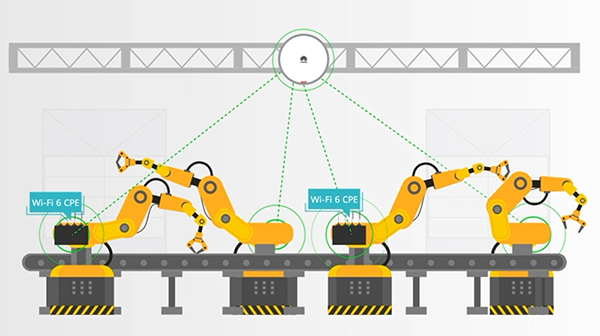
CPE application in the industrial interconnection scenario
In the above scenario, services are highly sensitive to packet loss and latency. To reduce the packet loss rate and latency, Huawei has introduced dual fed and selective receiving, a link-level protection technology over the air interface. After dual fed and selective receiving is enabled, two concurrent data links are established between a CPE and an AC. The transmission end (AC or CPE) duplicates data and sends two copies of the data over the two links (dual-fed process). The receiver end (CPE or AC) processes data that arrives earlier and discards the redundant data that arrives later (selective-receiving process). Compared with single-link transmission, dual fed and selective receiving has the following advantages:
- Reliability ≥ 99.999%: As traffic is transmitted over two links, a fault or packet loss on a single link does not interrupt services.
- Latency ≤ 10 ms: Based on the first-in first-out rule, the optimal link is selected to receive traffic, ensuring low service latency.
How Does Dual Fed and Selective Receiving Work?
Networking of Dual Fed and Selective Receiving
Before dual fed and selective receiving is introduced, a CPE accesses the upper-layer network through a single link. Data of terminals connected to the CPE is forwarded to an AP through a CPE tunnel, and is then transparently transmitted to the upper-layer server in direct or tunnel forwarding mode.
- CPE tunnel: a data channel established between a CPE and an AP. The CPE tunnel is essentially an Ethernet over GRE (EoGRE) tunnel that transparently transmits data from lower-layer wired terminals to an upper-layer network.
- CAPWAP tunnel: a data channel established between an AP and an AC. In tunnel forwarding mode, service data is transmitted to the AC for centralized forwarding.
Each of the dual-fed and selective-receiving links consists of a CPE tunnel and CAPWAP tunnel. The CPE must support two or more radios on different frequency bands (for example, 2.4 GHz and 5 GHz). After dual fed and selective receiving is enabled, the CPE associates its two radios with the APs which have the optimal signal strengths on the corresponding frequency bands. Therefore, the two radios of the CPE do not necessarily associate with the same AP. In this case, ensure that the two APs associate with the same AC.
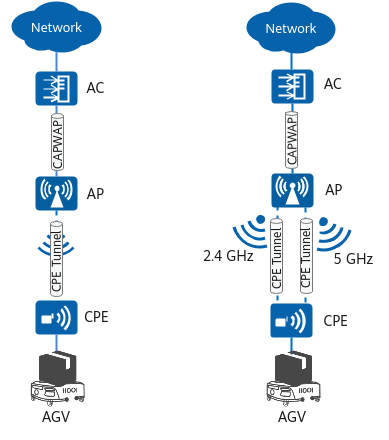
Single-link transmission (left) vs. dual fed and selective receiving (right) in tunnel forwarding mode
Dual-Radio Roaming of CPEs
To ensure that the network is not interrupted during roaming, a CPE manages the roaming handover of radio links. For example, if roaming occurs on one radio link, roaming can be triggered on the other radio link only after the on-going roaming is complete. In this way, even during roaming, there is always one link in stable connection state, greatly enhancing data transmission reliability.
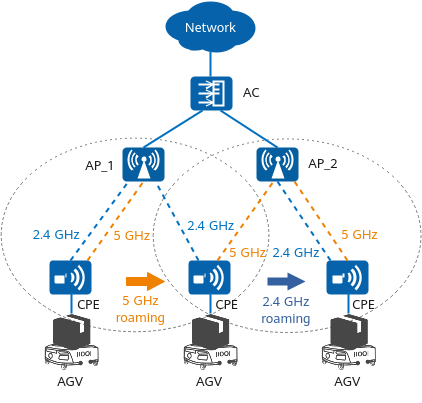
CPE roaming process in a dual-fed and selective-receiving scenario
What Are the Application Scenarios of Dual Fed and Selective Receiving?
Dual fed and selective receiving applies to scenarios where wired terminals connect to a WLAN through CPEs, such as smart warehousing, healthcare interconnection, and industrial interconnection, thereby meeting service requirements for low packet loss rate and latency in these scenarios.
Smart Warehouse and Logistics Scenario
In the smart warehouse and logistics scenario, automated guided vehicles (AGVs) access a WLAN through CPEs, reporting location and status information in a timely manner and obtaining running control instructions. Therefore, the AGVs can complete automatic picking and sorting under the management of the AGV scheduling system.
- Automatic picking: The background scheduling system controls AGVs to lift shelves to the picking area. AGVs wait in a queue for scanning the barcodes on parcels and putting them into logistics boxes.
- Automatic sorting: Sorting robots automatically scan the barcodes on parcels and deliver corresponding distribution instructions to sorting AGVs. The AGVs automatically navigate to specified sorting ports and put parcels into logistics boxes.
AGVs roam frequently, imposing high requirements on reliability and low requirements on throughput.
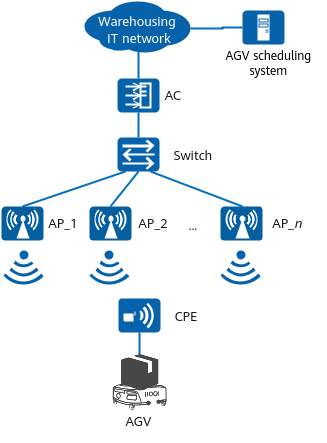
Typical networking in the smart warehouse and logistics scenario
Healthcare Interconnection Scenario
In the healthcare interconnection scenario, medical devices in the wards need to be connected to the data center to provide medical assistance. For example, medical staff can access electronic medical records (EMRs) during ward rounds by using mobile doctor workstations connected to the hospital information system. These devices are frequently moved to different wards or used on the move for higher device utilization. Therefore, they need to go wireless through CPEs, and dual fed and selective receiving is applied to ensure uninterrupted services during the device movement.
Healthcare interconnection scenarios impose high requirements on reliability and latency, but low requirements on throughput.
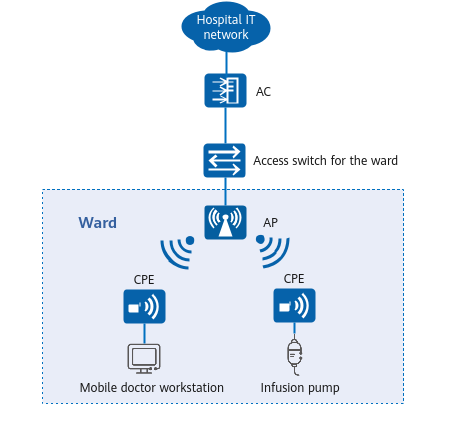
Typical networking in the healthcare interconnection scenario
Industrial Interconnection Scenario
In the industrial interconnection scenario, devices such as robot arms implement automatic production under the management of the programmable logic controller (PLC) system. When the PLC control server delivers tasks about operation and information collection, ultra-high reliability is required to ensure smooth production services. To meet such demands, dual fed and selective receiving is used to provide dual-radio link-level protection, ensuring high reliability and low latency.
In addition, a robotic arm can be bound to an AGV and move with it. In this case, both the AGV and the robotic arm access the WLAN through the CPE and roam from one AP to another.

Typical networking in the industrial interconnection scenario
- Author: Liu Jiayu
- Updated on: 2023-04-27
- Views: 2186
- Average rating:







